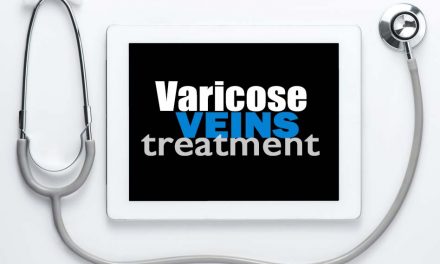
Varicose Vein Thrombophlebitis Can Be Dangerous

What is Varicose Vein Thrombophlebitis?
Thrombophlebitis (pronounced throhm-bow-fleh-bite-is), is a blocked vein in the leg which usually becomes irritated, reddened and hard to the touch. It involves the shallow leg veins. They can improve in a week or two or linger for many months.
Superficial thrombophlebitis (also called by its shorter name phlebitis) is a blood clot. It is not a deep vein blood clot. Deep vein clots require blood thinners and are more dangerous. They can travel to the heart or lungs.

Phlebitis usually occurs in the superficial leg veins especially varicose veins. Very commonly that superficial vein was a neglected bulging varicose vein.
It has been seen after an intravenous catheter has been placed. It has even been rarely associated with the veins of the penis and the breast. It’s not an insignificant problem with your circulation. When blood slows in the circulation in a vein, it’s like a stagnant pool. Stagnant water causes algae and fungus to form. When blood becomes stagnant, it can clot.
Although secondary infection of this condition has been described, I have never seen a case where a varicose vein clot has become infected. The most common scenario would be from an intravenous catheter, which was left in place too long. That would provide an entrance point for an infection. It is exceedingly rare to require removal or drainage of a septic thrombophlebitis.
There is confusion about thrombophlebitis
While researching thrombophlebitis on the common internet sources, I found some confusion and even downright inaccuracy on the subject. The most inaccurate statement was from Wikipedia, which stated that “thrombophlebitis is also referred to as “white leg”. Don’t believe everything that you read in Wikipedia.
White leg is also called milk leg or phlegmasia alba dolens. It is a rare but extensive blood clot in the deep veins and not the superficial veins. Superficial vein clots are usually more innocuous. However, in a few cases clot has extended from the superficial veins into the deep veins and resulted in death.
Phlebitis is not an infection.
Many patients who have been referred to me, a vascular surgeon, with thrombophlebitis by their primary care physician. Many patients were wrongly prescribed antibiotics. This is unnecessary because phlebitis is an inflammation. It is not an infection. It appears red and hot. Therein lies the confusion. A few patients have unnecessarily suffered from colitis from the antibiotics that they were given and were even hospitalized. Antibiotics should not be given for phlebitis!
What are the causes of thrombophlebitis?
Causes include varicose veins, immobilization, clotting disorders, hormonal imbalances, pregnancy and intravenous catheters. Varicose veins are the most common cause because blood does not move through these veins properly and becomes stagnant. Often this will happen after or during long car or plane rides.
I see a few cases of thrombophlebitis, which are referred to me every week. Almost all of the cases are associated with varicose veins, which have been neglected. People often tell me that their varicose veins did not hurt them before they developed the clot. This is why they ignored their varicose veins.
After taking a thorough history and physical examination, I carefully examine the entire venous system. It has been described that up to 8 % to 23% of people who were thought to have only a superficial clot but also had an occult deep vein clot which can be life threatening.
It is also important to know whether the clot has extended into the proximal saphenous veins. The superficial and deep veins connect in the groin and also behind the knee. Clot can grow or propagate into the deep veins at these points. If the clot is close to extending into the deep veins, blood thinners are necessary. An alternative is to tie off the proximal superficial vein to prevent the spread of the clot into the deep vein where it can break off and travel to the heart or lungs.
Once the clotting occurs, the inside lining of the vein is never the same. The smooth surface often becomes scarred with fibrous tissue. This rough surface is a set up for future episodes of thrombophlebitis. Therefore, phlebitis is often a recurring problem. In my opinion, it is not a benign condition.
Treatment of thrombophlebitis
Traditional treatment involves anti-inflammatory medication, frequent ambulation, elevation and compression support stockings. Ice or heat are often recommended as comfort measures.
The treatment of blood clots has become more aggressive lately in regards to anticoagulation or giving blood thinners. Decades ago, clots in the deep veins of the upper extremities were often treated without anticoagulation. This is no longer recommended.

Personally, I have observed propagation of clot in the distal to the proximal saphenous veins making later endovenous obliteration of that vein difficult or impossible. Many favor laser treatment of the saphenous vein while the clot is in its early stages.
Laser treatment can prevent the clot from growing from your varicose veins into the saphenous vein and the deep veins. That will prevent future problems and suffering.
Conclusion
Superficial varicose vein thrombophlebitis is a serious but usually not a life threatening condition. It may be a sign of an underlying clotting disorder.
Phlebitis can extend into the deep veins and become fatal if not closely followed and treated. It often recurs. It is not benign.
The latest recommendation and expert advice is to become more aggressive in the treatment of this problem. Allowing the clot to grow without intervention can lead to a chronic condition.
Observation can make definitive treatment of the saphenous vein, which are connected to these veins either difficult or impossible. It has resulted in long term morbidity and even death in some cases.
If you have had thrombophlebitis or know someone who has experienced it, referral to a vascular surgeon is highly recommended. We can be contacted at 724-987-3220 for more information on this often misdiagnosed and mistreated condition.









